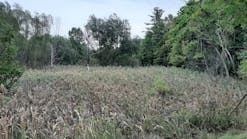Erosion control wattles, the “evolutionary step up” from hay bales, are cornering not only sediment but also, in many areas, the market as well. Wattles’ popularity appears to vary by geography: Coir wattles, made from imported coconut husk fiber, seem predominant in the eastern United States; rice-straw wattles, grown on the West Coast, take the home-court advantage.East Is East, and CoirFor bioengineering, riparian restoration, and erosion control projects, Jack White, executive director of Atlanta’s Southeast Waters, uses coir wattles in combination with other materials. “I try to use biodegradable materials as much as possible,” White says. “I use coir wattles on slopes, atop contours, along streambanks, or devegetated hillsides.”He uses products from RoLanka International, such as the BioD-Watl, which is made from coir fiber uniformly packed into a high-strength coir twine netting. Wattles are available in various diameters and 10-, 15-, and 20-ft. lengths. “Coir wattles promote absorption. The 12- to 20-inch-diameter size can work to anchor the bottom of slopes,” points out White.
Husks are cured in fresh water for at least six months.RoLanka, located in Stockbridge, GA, grows and processes its coir in Sri Lanka, then distributes the product from its Georgia office. Owner Calista Santha explains some of the process: “We don’t use the coconut hull you see in grocery stores. We process the outside, rounded-triangular husk. The husks are cured in fresh water for at least six months, which increases the processed fiber’s flexibility and durability without causing deterioration. The coir turns a dark brown color, and the fiber is graded according to its length. Longer, thicker, stronger fibers are called bristle coir; shorter, thinner fibers are called mattress coir. When, during processing, the fiber is separated from the husks, coir dust is left behind, which is stored in open air for two to three years before using. This moisture-retaining dust is sold to greenhouses and gardeners under a variety of trade names.”The nonprofit organization Southeast Waters routinely works with the Americorps program, municipal government agencies, and parks departments. In the firm’s six years, White (who’s personally worked in the industry twice that long) has used a variety of erosion control devices or products. “I’m not crazy about wattles in natural stream flows. For huge flows, I would rather use large rock or natural wood. Fascines [bundles of plant material], which perform the same function as wattles, can be superior to wattles in some instances. For example, if they’re made of willow, we may put the fascines into areas where they can grow. “However, on hillsides, wattles bend around contours, so I use them on top edges and midslopes,” White continues. “Wattles are also wonderful for overbank flows because they slow the water. Wattle installation is crucial to a successful project; you have to be careful how the water returns to the bank – make sure it doesn’t go under your construction. For insurance, we usually place fabric at the top of each project.“Another great use for wattles: You should have them if you’re working in a streambed, in case there’s a fast-rain event,” he maintains. “You’re obligated by law to not let soil go onto the stream surface. You can put the fabric and wattles in place quickly with stakes and work on the streambed. Unlike other materials, wattles give you effective coverage, erosion control, and sediment backup. Afterward, you can take them up, even if they’re wet, and use them again. Wattles don’t break apart, and they’re easy to use. Just one person can put in a lot of them. Coir wattles are available in 10- and 20-foot lengths; we usually use the 10s, and they’re easy to knit together.”The shorter, thinner mattress coir fibersFor permanent installations, coir stands up to Georgia’s climate. “Coir is much more permanent than straw; it has the potential to become part of the landscape. Even the 9-inch-diameter wattles rise only 3 to 4 inches out of the ground, and since they’re dark brown in color, they blend into the soil better. We sometimes seed wattles if they’re in a spot where we expect they will grow – especially on the top of a hill.” He notes that rain sometimes carries seed, and the wattles will stop the seeds and become covered with vegetation. “It takes two to five years for coir wattles to break down here, depending upon how wet they get, how much sunlight they’re exposed to, and how deep you put them down.” White prefers coir to the “old standby”: “Bales of hay rot, look terrible, and are hard to work with later,” he concludes. “Coir wattles are ‘it.'”Coir Is King in IndyCrafton Inc., located in Greenfield, IN, has been grading since the 1950s, but “only in the past five or six years we’ve gotten into erosion control,” Rick Crafton explains. “For the past two years we’ve been using King Fibre/Nutec Supply coir products. King Fibre sells the logs, and Nutec prevegetates them, if needed.”Indianapolis’ King Fibre Corporation, which is a division of Nutec Supply, offers coir wattles in its erosion control product line. King Fibre markets the wattles – or logs – and Nutec Supply seeds the logs for specific applications. “We perform niche jobs in erosion control. We go wherever the work takes us,” Crafton relates. “We recently did a ditch-lining job near Evansville [Indiana] to protect a watershed area near the ditch, which was draining too far into the park. We’ve done ditch repair here in the Indianapolis area and some shoreline stabilization at Lake Lemon, near Bloomington. We’ve done similar projects both ways; we’ve used nylon netting with stone in it and coir on top, and in other instances, we’ve dug out and put coir logs in. For larger reclamation projects, we build up using boulders, stabilize them with geogrid, then place prevegetated coir on top.“We use the 20-foot, 6- or 8-inch-diameter coir logs, and they’re all manageable; three or four guys can carry them, but that’s a lot of work,” Crafton explains. “We use a small excavator, like a Bobcat, to move them around. Nutec has a suggested staking pattern – we use 2-inch stakes and lash the logs down with a quarter-inch nylon rope.”Coir has worked well for Crafton thus far. “Nothing compares to this ‘plant log.’ Straw? You can’t plant seeds in it. Oh, yes, if you used an erosion control blanket with it, straw would work – but what we’re doing with erosion and wave control, probably not. Riprap? Again, you can’t establish plant growth.” He notes that the density of the coir logs remains consistent even after they’re soaked and have vegetation growing on them. “The prevegetated logs root up in a hurry. We haven’t yet had to redo anything nor seen anything deteriorate.” West Is West, and Rice StrawRice-straw wattles, a relatively new product, might not last as long as coir does, but they offer some different benefits from other straw products. In the past, the chaff from California’s large rice harvest was burned. Turning the chaff into rice-straw wattles has some air-quality benefits for the state. In addition, rice straw doesn’t contain weed seeds, as do hay bales or wheat straw. Because rice is grown in water, it breaks down more slowly than other straws. It is also resistant to most molds.Thunder Mountain Enterprises Inc. (TME) of Sacramento, CA, has been providing soil and water management services for several years, including preparing stormwater pollution prevention plans (SWPPPs), installing erosion and sediment control best management practices (BMPs), installing water containment ponds, and restoring native habitats, landscapes, and streams. TME uses tremendous amounts of rice-straw wattles from RH Dyck/Earth Saver in Winters, CA, as erosion control measures in design and application. “We chose the rice wattles over products containing other ingredients due to their value,” states TME’s Beth Smiley. “They work well, we think they’re cost-effective, and Earth Saver uses quality materials. They hold their form, are weed-free and firm, have consistent dimensions and density, and are easy to handle. We have specified and installed miles of wattles for sediment control measures. Straw wattles are a highly effective sediment control measure in most soils.”TME normally uses 9-in.-diameter, 25-ft.-long wattles. “Sometimes on smaller jobs or cut-up areas, we’ll use the 10-footers,” Smiley explains. “If required, we cut them to fit with a blade, take some of the stuffing out, then tie the [encasing] netting off. The stuffing you pull out can be used spread out on exposed dirt as erosion control.”She notes that the wattles are not difficult to install. “A shallow trench is dug. The wattles are then laid in the trench and staked securely. They’re not heavy or difficult to handle; I’m not a big person, and I can move them easily. Of course, though, they’re trickier when wet.”TME slowed the water velocity by placing wattles all the way down to the creek near the bridge.Wattles kept the slopes from washing into the subexcavated streets during construction.TME, which also installs long-term erosion control measures, such as permanent erosion control blankets and riprap, integrates wattles into its overall SWPPP designs as well. “We use them in slope applications as energy dissipaters to break up the length of the slope and slow the velocity of water, which has a tendency to drop sediment loads but still allows the discharge to leave the site. In channelized flows and slopes for permanent erosion control, the typical application would be seeded, and fertilizer either hydraulically or hand-broadcast, then a blanket placed to protect the seed and soil from raindrops. Wattles would be used at intervals based on steepness of slope and soil type. Eventually the slope is covered with vegetation, and the wattles will degrade after long exposure to [ultraviolet] light. A temporary blanket will also degrade. A permanent blanket will remain to support the vegetation and provide permanent erosion control.”Smiley describes two TME projects as proof of the wattles’ efficiency. In the fall of 2002, Sonora Hospital was under construction. With the wet season rapidly approaching, TME was retained by Sonora Hospital to come up with an amendment to the SWPPP design for the project. “With a predicted rainfall event less than a week away, we had to come up with a plan to stabilize slopes of two-to-one or greater and lengths of 100 feet,” says Smiley. “The plan was to hydroseed, then place blankets over the seed. On the higher slopes, we trenched-in and staked wattles, which slowed the water shed from the adjacent property. We were trying to beat the weather, so some areas had to be hydroseeded over the blanket, which is not the preferred application. Typically you want seed-to-earth contact, then the blanket. We completed the job just as the rain came. They received 2.5 inches of rain in three hours – a significant rainfall event! We succeeded in stabilizing the site, and this installation held together the entire winter. In contrast, a similar sloped site less than a mile down the road, on which another contractor had blown on bonded fiber matrix, had what the Regional Water Quality Board representative called ‘catastrophic failure.’ The soil there was a bit different.”Smiley cites another TME project in which Earth Saver lived up to its name. The Stoneridge Development in Roseville and Rocklin, CA, is a very dynamic site with creeks, Mehrton formation-type soils, and steep slopes. “There was a failure on the levee at the False Ravine Bridge, directly below a new bridge,” she explains. “The contractor was developing the long slopes below and around the bridge and had placed hay bales as the only line of defense at the top of the levees. The hay bales were not dug in well or staked.” In graded areas on the long, steep slopes above the bridge, dirt had been left exposed. During heavy rains, high-velocity runoff from the adjacent area to the creek below the bridge undermined the hay bales and washed away a part of the levee directly below the bridge. “We were called in to temporarily stabilize the slopes until dry season,” recalls Smiley. “We placed staked wattles parallel to the slope every 10 feet to slow the velocity of discharge down the levee slopes. We also placed geotextile fabric and rock bags in the blown-out area as erosion control to keep the soil particles in place and rock bags every 10 feet as a heavier energy dissipater to ensure no further deterioration of the slopes. We placed straw wattles on the disturbed slopes above the bridge to slow the water velocity and drop sediment loads. Although we were able to prevent any further erosion, during the next dry season the developer had to repair the levee under the bridge. Had they properly protected the slopes above the bridge and properly placed sediment and erosion controls like straw wattles, they could have prevented this costly levee repair.”Scott Stimmell of the Fremont, CA, Sansei Gardens, also finds uses for rice-straw wattles. As Sansei Gardens’s roots are in landscape construction, it doesn’t install permanent erosion control measures, such as riprap. “We were incorporated about 30 years ago, but in the last decade, we brought erosion control into the scope of work we perform,” Stimmell says. “We’ve been using Earth Saver wattles for the last six or seven years,” he continues. “We use them for slope stabilization and sedimentation control and behind curbs or sidewalks in new construction and subdivision projects. We’ll sometimes place wattles in front of finished, but unvegetated, pads. We formerly used silt fences, but wattles work better, offer more value for your money, and are definitely a marked improvement in stopping sediment. Wattles are used as a BMP because they work; they can save lots of time, money, and sediment-pollution penalties.”Whether the wattles stay or go depends on the project. “On a commercial or residential site, wattles are removed when we landscape, and we compost them. On slopes, the wattles remain to aid revegetation,” Stimmell explains. “The wattles’ photodegradable netting degrades in two to three years, unless the vegetation grows up around it. We don’t seed the wattles themselves; they’re used in conjunction with a seeding operation. In fact, we prefer the rice wattle because there isn’t seed in it. ‘Regular’ straw – wheat straw, for example – will have some seeds in it, and you don’t want that plant on your site.”Stimmell describes the “life” of a typical rice wattle on his projects: “This area’s clay/loam soil is highly erosive, so we use wattles on every erosion control site. We trench our wattles – place them in a shallow trench – then stake them down. To be effective, wattles have to be trenched and staked, per Earth Saver’s recommendation; otherwise the wattle will just roll away, or water goes under it. The wattles’ ends are always overlapped; you don’t want any gap between the sections – that will become the weak link. We typically use the 9-inch [diameter] 25-footers. They’re not heavy, and [they are] easily managed. A single employee can drag a couple of wattles up a slope – if they’re dry,” he chuckles.Sansei Gardens’s typical projects are large-scale and ongoing. “We’ve been working on a Marin County [California] project for almost three years. A Novato homebuilder is creating a large subdivision over several hundred acres.” The project includes a 220-unit apartment complex; 363 single-family detached units, each on 4,000- to 8,000-ft.2 lots; and a 100-unit senior housing center. “Needless to say, the project contains many building pads, as well as newly graded slopes of grades two-to-one or less,” says Stimmell.“At the beginning of winter, the rainy season, the subexcavated streets were of greatest concern,” Stimmell explains. “They would have provided a perfect route for stormwater, which could have washed out slopes and moved sediment throughout the site. With the wattles, we built ‘speed bumps’ for the water, to slow its velocity. By placing wattles every 20 feet, perpendicular to the flow, we prevented scouring of the roadbase and stopped sediment along the way, rather than catching it at the bottom of the hill. The wattles functioned as a check dam.“We couldn’t have done this with silt fences,” he adds. “Out here, silt fences clog because of the soil’s fine clay particles. Plus, the average silt fence has an 18- to 24-inch profile, which wouldn’t have worked in the streets that were being used by construction vehicles.”After the streets were installed, wattles were placed behind the paving to keep unfinished pads from washing out.When the construction timetable and weather allowed, the wattles were removed and the streets received base rock, asphalt, and storm drains. “The removed wattles were then placed behind the paving to keep unfinished pads from washing out.” As the site expands, the work goes on. “Even with reusing some wattles, we still have placed upward of 100,000 feet, or 10 truckloads, of wattles on this job, and it’s still underway,” Stimmell concludes.California Straw Works – LiterallyIn Sacramento, Nitta Construction is involved in work for the California Department of Transportation (Caltrans) and other large projects. “Eighty-five percent of our jobs are in public works, such as for Caltrans, on roadsides, or near bridges and interchanges,” notes Scott Nitta, the company’s vice president. “Typically it’s new construction, although some were storm-damage projects too. We use straw wattles for surface sediment in conjunction with permanent or other temporary erosion control products. In a permanent installation, we’ll put in netting and blankets and maybe do some hydroseeding with tackifier. We’ll put the wattles at the toe of the slope, perpendicular to the slope face, in the direction of the slope flow. As the wattle slowly rots, some sort of vegetation will grow into it.”Nitta uses Straw Wattles from California Straw Works in Loomis, CA, founded by Sherryn Haynes. “We didn’t use any other kind of wattles before these,” Nitta says. “As long as Haynes has been in business – five or six years – we’ve been using [California Straw Works]. When rice-straw wattles came out they were revolutionary; they were said to replace silt fences. Rice-straw wattles work – and we’ve used them in many, many projects. Caltrans was probably the first to use them, but rice-straw wattles are now filtering down to other government and private projects. Not only do wattles work well, but they also eliminate a big environmental issue: California produces huge amounts of rice, and in the past the rice straw was burned. Now it’s recycled.”When wattles are used as a temporary measure, they’re often transferred to another job. “We leave them in place, but some construction or landscape workers will pick them up and maybe take them to another site,” says Nitta.He explains his installation procedures: “We use the 9-inch-diameter, 25-foot-long rolls, although some projects, such as those for Caltrans, require wattles 3 to 6 meters in length. The wattles aren’t heavy, but they’re more cumbersome if not wrapped up. We usually cut ours into quarters – about 7 feet long, so they’re no more than about 20 to 30 pounds. Of course, though, the jute netting itself can get to about 40 pounds – it comes in a 4- by 225-foot roll.“We use different methods to secure the wattles. There’s the furrow method, in which you dig a small trench and secure the wattles in with stakes. In the rope-restraint method, you take biodegradable rope, one-quarter to three-eighths inch in diameter, and weave the rope around the wattle and around notched wooden stakes, which have been cut from two-by-four blanks. Caltrans prefers the restraint method, which is slower going; we also usually use netting with that method. For our other jobs, we place wattles in a 2- to 3-inch trench – at least on sites up to a two-to-one slope; steeper than that, digging is difficult, and the restraint method works better.”What type of material works best on the site still determines what Nitta uses. “We still do silt fence jobs. Wattles haven’t completely replaced them.”





